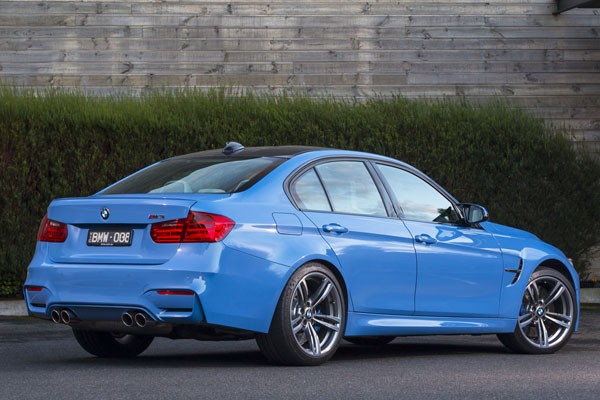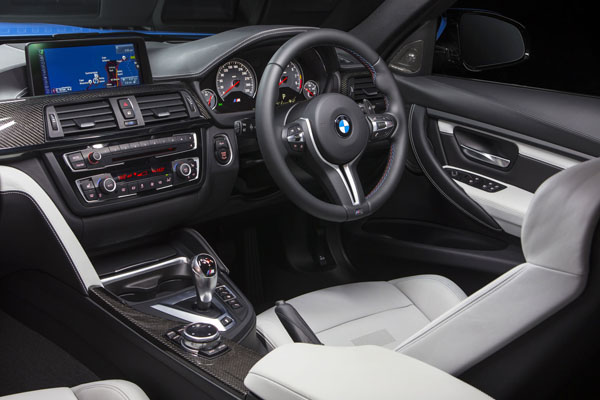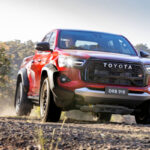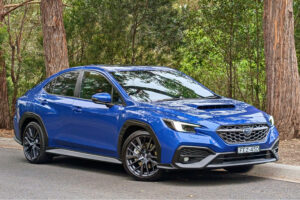BMW has taken a bit of a gamble with its latest M3 performance car, firstly by replacing the V8 engine with a new twin-turbo six and by renaming the coupe and convertible variants as M4s leaving the M3 only available as a four-door sedan.
Purists will no doubt mourn the passing of the V8’s throaty growl but should be placated by the added power and torque from the new turbo six, while the name change for the two-door models is part of BMW’s even-number policy and may quickly be accepted.
STYLING
The new M3 has a chunkier look than before, with the wheels pushed further out to the sides of the car, taking bulging wheel arches with them. As before, the long BMW bonnet features a bulging power dome in its centre, needed to contain the large intercooler fitted underneath.
Inside there are plenty of M Sport features including carbon-fibre trim, Merino leather sports seats and sports steering wheel with M contrast stitching. The powered front seats come with adjustable side bolsters to combine comfort with support for a variety of rump sizes.
ENGINE / TRANSMISSION
New BMW M3 is powered by a 3.0-litre in-line six with a pair of turbochargers. Despite the reduction in capacity from the superseded 4.0-litre V8 it generates marginally more power (317 kW compared to 309 kW) but, more importantly, nearly 40 per cent extra torque (550 Nm against 400).
The twin-turbos deliver that torque all the way from 1850 to 5500 rpm – the V8 didn’t reach its peak until 3900 revs.
The zero to 100 km/h sprint is listed at 4.1 seconds, again beating the V8 which stopped the clock 0.6 seconds later.
Fuel economy isn’t high on the priority list of performance car buyers but, given that it comes with four doors and extra interior space, the M3 can also serve as an everyday drive car and so the reduction in the official numbers from 11.9 litres per 100 kilometres in the V8 to 8.3 L/100 km in the six does become relevant.
Transmission is through an improved version of BMW’s seven-speed M double-clutch transmission, a gearbox that outperforms the no-cost optional six-speed manual transmission and with the benefit of steering-wheel mounted shift paddles.
SAFETY
A car with the performance of the BMW M3 needs the best in safety equipment and this includes six airbags, ABS brakes, traction and stability control, corner braking control, and dynamic braking lights that set off the hazard lights under extreme braking.
There is also Active Crash Protection, a safety feature that activates a series of protective measures if a crash is imminent, including closing the windows and sunroof (if fitted), tightening the seat belts, and post-collision.
With the family in mind there are IsoFix attachment points in the rear for child safety seats.
DRIVING
Our initial drive of the new M3 was at its Australasian launch in New Zealand where the emphasis was on track testing. This time around we’re back into our home territory to see how it copes with the less challenging but more real-life conditions.
Performance cars are sometimes a bit of a handful in everyday city conditions but the M3 proved to be comfortable and relaxing around town. With four doors, seating for five (preferably four in the rear and then sub-six foot in height) and a 480-litre boot it can adapt to the requirements of most small families.
As with any M car, there’s a choice of settings to adjust engine, gearbox, suspension and steering. Each has three modes – Comfort, Sport and Sport+. Within the city limits and on the motorway Comfort was the obvious choice and provided what the name promised.
Once onto our favourite country roads and without any passengers on board we were able to flick the switch to Sport or Sport+ and give the little Beemer its head. With the twin turbochargers combining to virtually eliminate turbo lag acceleration is all but instantaneous. At low revs and speeds you do feel the lag, but once that’s been overcome it’s a real delight to drive with fast response and a new engine note that, while quite different from the distinctive V8 tone can be just as rewarding.
The new M3 officially uses just 8.3 litres per 100 kilometres on the combined driving cycle. In real life we found it using 11 to 13 litres per hundred kilometres under reasonably sensible driving, climbing past 15 litres per hundred if you do get stuck into it. Open road and motoring driving did bring it down to eight to nine litres per hundred.
SUMMING UP
The new engine, together with a reduction in weight of around 60 kg through the use of a variety of lightweight materials, in particular carbon-fibre reinforced plastic (CFRP) and aluminium, mean improvements in fuel consumption and emissions. CFRP had been used previously but only in the old M3 coupe.
Those who want a single car that will allow them to combine their passion for driving with the convenience of a small-medium four-door sedan should seriously consider the new BMW M3.
At $156,900 plus on-road costs it’s around $8000 dearer than the previous model, however BMW has priced the added value of extra standard equipment at around double that amount
AT A GLANCE
MODEL RANGE
M3 3.0-litre twin-turbo petrol two-door coupe: $156,430 (manual and automatic)
Note: This price does not include government or dealer delivery charges. Contact your local BMW dealer for driveaway prices.
FEATURES
ABS Brakes: Standard in all models
Automatic Transmission: Standard in all models
Cruise Control: Standard in all models
Dual Front Airbags: Standard in all models
Front Side Airbags: Standard in all models
Electronic Stability Program: Standard in all models
Rear Parking Sensors: Standard in all models
Reversing Camera: Standard in all models
USB/Auxiliary Audio inputs: Standard in all models
Bluetooth: Standard in all models
Steering wheel mounted controls: Standard in all models
SPECIFICATIONS (BMW M3 3.0-litre twin-turbo petrol four-door sedan)
ENGINE:
Engine Capacity: 2.979 litres
Configuration: Six cylinders in line
Head Design: DOHC, four valves per cylinder
Compression Ratio: 10.2:1
Bore/Stroke: 89.6 mm x 84.0 mm
Maximum Power: 317 kW @ 5500-7300 rpm
Maximum Torque: 550 Nm @ 1850-5500 rpm
DRIVELINE:
Driven Wheels: Rear
Manual Transmission: Six-speed
Automatic Transmission: Seven-speed
Final Drive Ratio: 3.462:1
DIMENSIONS, WEIGHT AND CAPACITIES:
Length: 4671 mm
Wheelbase: 2812 mm
Width: 1870 mm
Height: 1430 mm
Turning Circle: 12.2 metres
Kerb Mass: 1520 kg
Fuel Tank Capacity: 60 litres
Towing Ability: Not supplied
Boot Capacity: 480 litres (1300 litres with rear seatbacks folded)
SUSPENSION AND BRAKES:
Front Suspension: Aluminium double-joint spring strut axle with displaced camber, small positive steering roll radius, compensation of lateral forces, anti-dive
Rear Suspension: Five-link axle in lightweight steel construction
Front Brakes: Ventilated disc
Rear Brakes: Ventilated disc
PERFORMANCE:
0-100 km/h Acceleration: 4.1 seconds
FUEL CONSUMPTION:
Type: Petrol 95RON
Combined Cycle (ADR 81/02): 8.3 L/100km
GREEN VEHICLE GUIDE RATINGS:
Greenhouse Rating: 6.5/10
Air Pollution Rating: 7.5/10
STANDARD WARRANTY:
Three years/unlimited km












